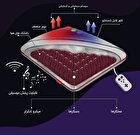Iranian Researchers’ Innovative Method Empowers Elbows of Patients with Spinal Cord Injury

“This research was carried out with the aim of empowering patients with spinal cord injuries of level 6/C5C. By recording and processing the brain signals (EEG) and the electrical activity of healthy muscles (EMG), the voluntary movement information of the person is estimated. By using this information and artificial intelligence, voluntary movements are known and by stimulating the defective muscle, movements like drinking water, answering the phone, moving objects and pouring water from a pitcher can be done,” said Mahdiyeh Khaliq Fard, a student of Amirkabir University of Technology.
Elaborating on the results of this project, she noted, “Reconstruction of three-dimensional paths in daily life activities using vital EEG and EMG signals improves the practical development of mobility aids for patients.”
Khaliq Fard stated that the basic limitations like atrophy or early fatigue of muscles, using only the EMG signal of people with mobility disabilities has been a challenge, adding, “Low accuracy, low data transfer rate and the need for high individual attention are among the limitations of using only the EEG signal.”
“Therefore, with the proper use of a combination of these vital signals with the aim of reducing the limitations, it is a new approach that requires a selection of a combined structure,” Khaliq Fard said.
In a relevant development in August, Iranian researchers at University of Tehran had also succeeded in designing control algorithms for lower body rehabilitation exoskeletons for disabled people.
“I have designed one of the most up-to-date control algorithms for this category of external skeletons called Virtual Energy Regulator,” said Rezvan Nasiri, a member of the Faculty of Machine Intelligence and Robotics Department of the University of Tehran.
“This algorithm can coordinate with the user's performance and therefore has the best performance compared to other control algorithms developed so far,” she underlined.
Noting that most of the physically disabled people need lower body rehabilitation to walk or are unable to walk at all, Nasiri said that these people are the elderly, people with spinal cord injury, stroke-hit people, Parkinson's patients, etc.
“Our research group was able to propose, for the first time at the international level, a model of force distribution among muscles with 75% accuracy, and this is a big step in the direction of reducing research costs and accelerating research in the field of rehabilitation robots,” she added.
4155/v
























